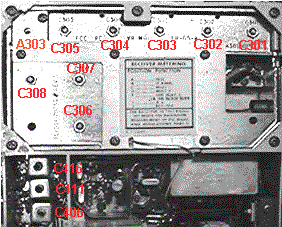MASTR
II UHF Receiver Re-Alignment
ICOM Adjustment
 Before
you align the receiver, you need to net you receiver ICOM. ICOM frequency
adjustments are made by attaching a frequency counter at the junction of
C417 and C415 (shown in the picture to the right, top right corner) which
is located to the right of L403. In a UHF receiver the frequency you want
to adjust the ICOM to is the receive frequency less 11.2 MHz divided by
3.
Before
you align the receiver, you need to net you receiver ICOM. ICOM frequency
adjustments are made by attaching a frequency counter at the junction of
C417 and C415 (shown in the picture to the right, top right corner) which
is located to the right of L403. In a UHF receiver the frequency you want
to adjust the ICOM to is the receive frequency less 11.2 MHz divided by
3.
An example, if you wished to receive on 447.275 MHz, subtract 11.2 MHz
(the IF frequency) and divide by 3. This results in the frequency
you will tune the ICOM, in this case, 145.358333 MHz.
To properly adjust the ICOM frequency, you need to factor
in the room temperature and be sure the receiver is at room temperature.
UHF Receiver Re-Alignment
All measurements are against ground (pin 9 of J-601. Use an analog meter
or VTVM for all measurements.
 Adjust C406 for
maximum reading at J601-3.
Adjust C406 for
maximum reading at J601-3.

 Pre-set C411 and C416 in a similar position as C406 then pre-set C306,
C307, and C308 fully counterclockwise.
Pre-set C411 and C416 in a similar position as C406 then pre-set C306,
C307, and C308 fully counterclockwise.
 Adjust C411 and
C416 for maximum meter reading, then re-tune C406, C411, and C416 for maximum
meter reading at J601-4.
Adjust C411 and
C416 for maximum meter reading, then re-tune C406, C411, and C416 for maximum
meter reading at J601-4.
 Tune C307 and
C306 for maximum meter reading at P601-7, then repeat this process.
Next tune C308 for minimum meter reading and re-tune C306 for maximum meter
reading. Do not re-adjust C307 or C308.
Tune C307 and
C306 for maximum meter reading at P601-7, then repeat this process.
Next tune C308 for minimum meter reading and re-tune C306 for maximum meter
reading. Do not re-adjust C307 or C308.
 Move you meter
to J601-1 and apply an on frequency signal to the antenna jack and tune
C301 through C305 and A303 for maximum meter reading. You can
also re-adjust C306, C307 and C308 but not more that 1/4 turn. Reduce
the signal level being feed in to the receiver and repeat as many time
as required, reducing the injected signal until no further sensitivity
can be obtained.
Move you meter
to J601-1 and apply an on frequency signal to the antenna jack and tune
C301 through C305 and A303 for maximum meter reading. You can
also re-adjust C306, C307 and C308 but not more that 1/4 turn. Reduce
the signal level being feed in to the receiver and repeat as many time
as required, reducing the injected signal until no further sensitivity
can be obtained.
This site, its contents, and look & feel are Copyrighted©
2001 Kevin Custer W3KKC
All Rights Reserved.
 Before
you align the receiver, you need to net you receiver ICOM. ICOM frequency
adjustments are made by attaching a frequency counter at the junction of
C417 and C415 (shown in the picture to the right, top right corner) which
is located to the right of L403. In a UHF receiver the frequency you want
to adjust the ICOM to is the receive frequency less 11.2 MHz divided by
3.
Before
you align the receiver, you need to net you receiver ICOM. ICOM frequency
adjustments are made by attaching a frequency counter at the junction of
C417 and C415 (shown in the picture to the right, top right corner) which
is located to the right of L403. In a UHF receiver the frequency you want
to adjust the ICOM to is the receive frequency less 11.2 MHz divided by
3.
